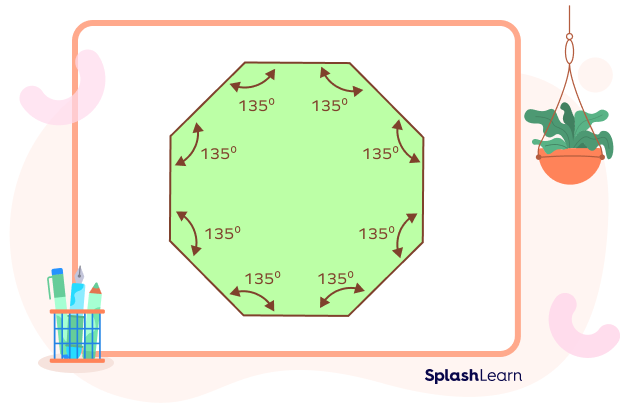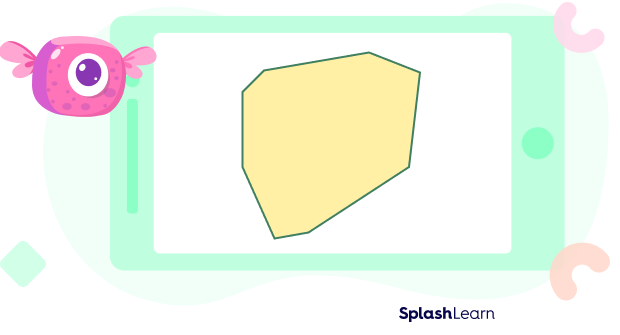
What is an Ocatgon Shape?
Hey! I am an OCTAGON SHAPE. I belong to the POLYGON family. Now, what is a polygon? Very simple. It is a closed plane figure with at least three straight sides and angles, typically five or more. You are already familiar with some of my family members, like the triangle and the square.
I’m sure you have all seen a stop octagonal sign; it is red and vehicles stop when they see this sign. A stop sign is generally in the an octagon shape—a closed two-dimensional figure with eight sides and eight vertices.

Properties of an Octagon

- It is a polygon with eight sides and eight angles.
- There are a total of 20 diagonals in it.
- All its interior angles sum up to 1080°.
- The sum of its all the exterior angles is 360°.
Types of Octagons
Depending on the measure of the sides and angles, octagons can be classified into the following types:
- Regular and Irregular Octagons
- Convex and Concave Octagons
Regular and Irregular Octagons
Regular Octagon
A regular octagon shape has eight equal sides and eight equal angles. All the sides are of equal length, and all the angles are of equal measure. The sum of the interior angles is 1080°, and the sum of the exterior angles is 360°. In a regular octagon, the interior angle at each vertex is 135°.

Irregular Octagon
In an irregular octagon shape, the eight sides and eight angles are unequal. All the sides are not equal in length, and all the angles are not equal in measure. Though the interior angles are of different measures, they still add up to 1080°.

Convex and Concave Octagons
Convex Octagon
An octagon that has all its angles pointing outside or no angles pointing inwards is a convex octagon shape. Convex octagons bulge outwards. None of the interior angles is greater than 180° in a convex octagon.

Concave Octagon
The octagon in which at least one of the angles points inwards is a concave octagon shape. A concave octagon have atleast one edge pointing towards inwards. This means that at least one of the interior angles is greater than 180° in a concave octagon.

Fun Facts
- The word “octagon” has been derived from the Greek word ὀκτάγωνον (oktágōnon), which means eight angles. This is how the shape with eight angles was named octagon.
- During the 1850s and 1900s, many people started building their homes in the shape of an octagon as it is a symbol that represents rebirth, infinity, regeneration, and transition.
- Umbrellas often have an octagonal-shaped outline.

Perimeter of an Octagon
The perimeter of a two-dimensional shape is the total length of the boundary. It is the sum of the length of all sides.
Perimeter of a Regular Octagon
The formula to calculate the perimeter of a regular octagon shape = 8 ✕ side. Here, “side” refers to the length of the equal sides of a regular octagon.
Perimeter of an Irregular Octagon
For an irregular octagon shape, the perimeter is calculated by adding together the individual side lengths. So, the perimeter would be the sum of the lengths of all 8 sides.
Solved Examples
Example 1. If the length of the side of a regular octagon is 10 cm, find its perimeter.
Solution:
The length of the side of the given regular octagon is 10 cm.
The formula to calculate the perimeter of a regular octagon is 8 ✕ side.
Therefore, the perimeter of the given regular octagon = 8 ✕ 10 = 80 cm.
Example 2. If the perimeter of a regular octagon is 200 cm, find the length of its side.
Solution:
The perimeter of the regular octagon is 200 cm (given).
The formula to calculate the perimeter of a regular octagon is 8 ✕ side.
Therefore, we have,
8 ✕ side = 200
Side = $\frac{200}{8}$ = 25 cm.
Example 3. Find the perimeter of an irregular octagon whose side lengths are 6 cm, 16 cm, 14 cm, 20 cm, 12 cm, 8 cm, 10 cm, and 18 cm.
Solution:
The side lengths of the given irregular octagon are 6 cm, 16 cm, 14 cm, 20 cm, 12 cm, 8 cm, 10 cm, and 18 cm (given).
The perimeter of the irregular octagon would be the sum of the lengths of all 8 sides.
Perimeter = (6 + 16 + 14 + 20 + 12 + 8 + 10 + 18) cm
Therefore, the perimeter of the given irregular octagon = 104 cm.
Practice Problems
Octagon - Definition With Examples
Identify the type of octagon given below.

This is because the sides are not of equal length.
If the length of each side of a regular octagon is 20 cm, find its perimeter.
Formula for perimeter of regular octagon = $8$ ✕ $side$.
Therefore, perimeter of the given regular octagon = $8$ ✕ $20$ = $160$ cm.
Each interior angle of a regular octagon is ________________.
The measure of each interior angle of a regular octagon is 135°.
Find the perimeter of an irregular octagon whose side lengths are 3 cm, 7 cm, 8 cm, 5 cm, 4 cm, 6 cm, 10 cm, and 9 cm.
The perimeter of an irregular octagon would be the sum of the lengths of all 8 sides.
Perimeter $= (3 + 7 + 8 + 5 + 4 + 6 + 10 + 9)$ cm
Perimeter $= 52$ cm.
Frequently Asked Questions
Are all eight-sided shapes called octagons?
An eight-sided shape is an octagon only if the shape is closed and made up of straight lines.
What is the sum of the angles of an irregular octagon?
The angles of the irregular octagon are unequal. Still, they measure up to a sum of 1080°. This is the same as a regular octagon.
What are the differences between a convex octagon and a concave octagon?
Convex Octagon: A convex octagon has all its angles pointing outside. In other words, no angles point inwards. Convex octagons bulge outwards. None of the interior angles is greater than 180°.
Concave Octagon: A concave octagon has one of the angles point inwards. At least one of its interior angles is greater than 180°.

